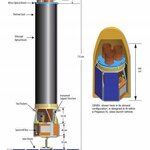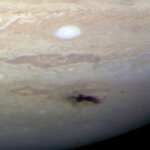Space

One of the current questions for the future of space exploration is whether to return to the moon, or just head to Mars.
Should we return somewhere we’ve been before? Or just strike out toward someplace totally new? Is there any benefit to going back to the moon? Can we make it to Mars without building up our endurance and scientific knowledge on the moon first?
There are intelligent, well-connected, even famous, proponents on both sides.
Going to the moon is a much shorter trip, obviously. It will not require new technology, though an update of Apollo-era tech would definitely be in order.…

Hitler's gift to astronomy? What?
Believe it or not, Hitler wanted to give Mussolini and Rome a planetarium*. Rome was among the first in the world to build a planetarium. Italy (and Mussolini) had already taken a planetarium as part of the 'compensation' for the damage Germany did to Italy in WW1 and opened the first Roman planetarium already in 1928.
It is the most peculiar story, so much so that I feel compelled to tell, however little, what I know about this hidden treasure of planetarium history...
It started, of course, with my interest in astronomy and my social media activities. 2009…

HD 87643, a member of the exotic class of B[e] stars, is in a very rich field of stars towards the Carina (the Keel) arm of the Milky Way. It recently became part of a set of observations that provide astronomers with the best ever picture of a B[e] star.
B[e] stars are stars of spectral type B, with emission lines in their spectra, hence the "e". They are surrounded by a large amount of dust.
The image was obtained with the Wide Field Imager (WFI) attached to the MPG/ESO 2.2-meter telescope at the 2400-metre-high La Silla Observatory in Chile. The image shows the extended nebula of gas and…

Betelgeuse, the second brightest star in the constellation of Orion (the Hunter), is a red supergiant, one of the biggest stars known, and almost 1,000 times larger than our Sun.
To put that in perspective, if Betelgeuse were at the center of our Solar System it would extend out almost to the orbit of Jupiter, engulfing Mercury, Venus, Earth, Mars and the main asteroid belt.
Betelgeuse is also one of the most luminous stars known, emitting more light than 100,000 Suns but, in true Neil Young fashion, its extreme lifestyle is causing it to burn out rather than fade away. This stellar…

Electromagnetic radiation (light, radio waves, X-rays, and microwaves) contains a varying electric field. When we talk about Polarization of this field, we refer to its direction. A new satellite named the Gravity and Extreme Magnetism Small Explorer (GEMS), will be the first to systematically measure the polarization of cosmic X-ray sources. It is a new astrophysics mission led by NASA's Goddard Space Flight Center in Greenbelt, Md.
Goddard will provide the X-ray mirrors and polarimeter instrument for GEMS and oversee the mission's science operations center, science data processing…

A new study in Nature offers an explanation for the origin of dwarf spheroidal galaxies, one of the current puzzles in our understanding of galaxy formation.
Dwarf spheroidal galaxies are small and very faint, containing few stars relative to their total mass. They appear to be made mostly of dark matter - a mysterious substance detectable only by its gravitational influence, which outweighs normal matter by a factor of five to one in the universe as a whole.
Astronomers have found it difficult to explain the origin of dwarf spheroidal galaxies. Previous theories require that dwarf…

Enjoy star gazing? Lucky enough to be in the northern hemisphere August 11th and 12th?
Look to the skies to take in the Perseid Meteor Shower, named after the constellation Perseus. Perseid is observable from the southern hemisphere, but they do not get the full effect of this 60 meteor per hour show. In Greek mythology, Perseus was the hero who slayed Medusa and later rescued and married the beautiful Andromeda. We've been looking to the heavens for inspiration and enjoyment for millenia. Our observation of the Perseid meteor shower goes back 2000 years and has been written…

Citizen scientists working through an online project called Galaxy Zoo have discovered a group of rare galaxies called the "Green Peas" which could lend unique insights into how galaxies form stars in the early universe.
Galaxy Zoo users volunteer their spare time to help classify galaxies in an online image bank. When they came across a number of objects that stuck out because of their small size and bright green color, they dubbed them the Green Peas. Employing the help of the volunteers to further analyze these strange new objects, the astronomers discovered that the Green Peas are…

A surprising impact on Jupiter is big news this past week. The eyes of the entire space world have been riveted on the discovery of amateur astronomer Anthony Wesley of Canberra, Australia. Now Hubble is in on the act and has provided the clearest picture yet.
This Hubble picture, taken on 23 July, is the sharpest visible-light picture taken of the dark spot and is Hubble's first observation following its repair and upgrade in May. Observations were taken with Hubble's new camera, the Wide Field Camera 3 (WFC3). The WFC3 was installed in May and is not yet fully calibrated…

You don't want carbon dioxide (CO2) build up in your space suit. Even those who argue to love huge CO2 emissions into our atmosphere should learn from the AP news: Two astronauts cut short their spacewalk and hurried back to the safety of the international space station (ISS) on Wednesday after a suit problem resulted in rising carbon dioxide levels for one of the men.
First, here is an image of a spacewalk. Two astronauts, Robert L. Curbeam (USA) and Christer Fuglesang (Sweden), work to attach a new truss segment to the ISS and begin to upgrade the power…